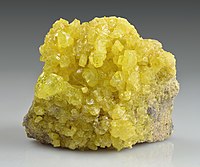
Photo from wikipedia
Over 3000 mercury (Hg)-contaminated sites worldwide contain liquid metallic Hg [Hg(0)l] representing a continuous source of elemental Hg(0) in the environment through volatilization and solubilization in water. Currently, there are… Click to show full abstract
Over 3000 mercury (Hg)-contaminated sites worldwide contain liquid metallic Hg [Hg(0)l] representing a continuous source of elemental Hg(0) in the environment through volatilization and solubilization in water. Currently, there are few effective treatment technologies available to remove or sequester Hg(0)l in situ. We investigated sonochemical treatments coupled with complexing agents, polysulfide and sulfide, in oxidizing Hg(0)l and stabilizing Hg in water, soil and quartz sand. Results indicate that sonication is highly effective in breaking up and oxidizing liquid Hg(0)l beads via acoustic cavitation, particularly in the presence of polysulfide. Without complexing agents, sonication caused only minor oxidation of Hg(0)l but increased headspace gaseous Hg(0)g and dissolved Hg(0)aq in water. However, the presence of polysulfide essentially stopped Hg(0) volatilization and solubilization. As a charged polymer, polysulfide was more effective than sulfide in oxidizing Hg(0)l and subsequently stabilizing the precipitated metacinnabar (β-HgS) nanocrystals. Sonochemical treatments with sulfide yielded incomplete oxidation of Hg(0)l, likely resulting from the formation of HgS coatings on the dispersed µm-size Hg(0)l bead surfaces. Sonication with polysulfide also resulted in rapid oxidation of Hg(0)l and precipitation of HgS in quartz sand and in the Hg(0)l-contaminated soil. This research indicates that sonochemical treatment with polysulfide could be an effective means in rapidly converting Hg(0)l to insoluble HgS precipitates in water and sediments, thereby preventing its further emission and release to the environment. We suggest that future studies are performed to confirm its technical feasibility and treatment efficacy for remediation applications.
Journal Title: Journal of hazardous materials
Year Published: 2022
Link to full text (if available)
Share on Social Media: Sign Up to like & get
recommendations!